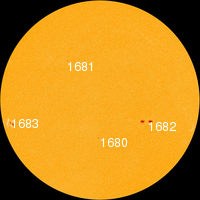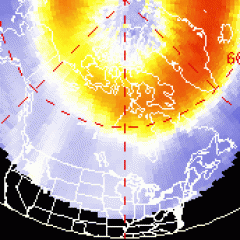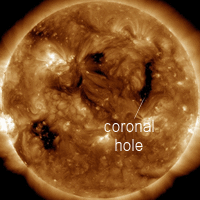NEW RADIATION BELT DISCOVERED: NASA's twin Van Allen Probes, launched just last August, have revealed a previously unknown third radiation belt around Earth. Get the full story from Science@NASA.
GEOMAGNETIC STORM: A minor (Kp=5) geomagnetic storm is underway around the poles. The cause is a medium-speed (~500 km/s) stream of solar wind that hit Earth's magnetic field during the late hours of Feb. 28th. Reports of auroras are coming in from around tthe Arctic Circle, like these photographed by Frank Olsen of over Norway:
"The weather here in Vesterålen has been terrible for more than a week," says Olsen. "I was so glad the clouds parted so we could catch the auroras at 1:30 am local time on March the 1st."
More auroras are in the offing. NOAA forecasters estimate a 20% to 25% chance of polar geomagnetic storms on March 2-3 as the solar wind continues to blow. Aurora alerts: text, voice.
COMET PAN-STARRS UPDATE: Comet Pan-STARRS, now visible in the southern hemispherre, is brightening as it plunges toward the sun, Amateur astronomer Ian Cooper sends this report from Glen Oroua, New Zealand: "Despite lingering evening twilight and the glare from a nearly full Moon, Comet Pan-STARRS is a 3rd-magnitude object with a fine orange dust tail visible in both binoculars and small telescopes." A 30-second exposure with his Canon 450D digital camera easily revealed the comet in the not-quite-dark sky:
In early March, the comet will pass about 100 million miles from Earth as it briefly dips inside the orbit of Mercury. At that time it is expected to brighten another three-fold to 2nd magnitude, about as bright as the stars in the Big Dipper. Whether Pan-STARRS will actually be visible to the naked eye through the glow of the nearby sun remains to be seen; this NASA video explores the possibilities. Whatever happens, observers in the northern hemisphere will have a front row seat as the comet crosses the celestial equator on March 12th. Stay tuned!
More about Comet Pan-STARRS: 3D orbit, ephemeris, light curves.

![]()
Solar wind
speed: 884.5 km/sec
density: 4.2 protons/cm3
explanation | more data
Updated: Today at 1457 UT
![]()
X-ray Solar Flares
6-hr max: B6 1014 UT Mar01
24-hr: B6 1014 UT Mar01
explanation | more data
Updated: Today at: 1500 UT
![]()
![]()
![]()
Daily Sun: 01 Mar 13
![]()
![]()
Sunspot AR1682 has a 'beta-gamma' magnetic field that harbors energy for M-class flares. Credit: SDO/HMI
![]()
![]()
![]()
Sunspot number: 63
What is the sunspot number?
Updated 01 Mar 2013
Spotless Days
Current Stretch: 0 days
2013 total: 0 days (0%)
2012 total: 0 days (0%)
2011 total: 2 days (<1%)
2010 total: 51 days (14%)
2009 total: 260 days (71%)
Since 2004: 821 days
Typical Solar Min: 486 days
Update 01 Mar 2013
The Radio Sun
10.7 cm flux: 106 sfu
explanation | more data
Updated 01 Mar 2013
![]()
![]()
![]()
Current Auroral Oval:
![]()
Switch to: Europe, USA, New Zealand, Antarctica
Credit: NOAA/POES
![]()
![]()
![]()
Planetary K-index
Now: Kp= 5 storm
24-hr max: Kp= 5 storm
explanation | more data
![]()
Interplanetary Mag. Field
Btotal: 10.0 nT
Bz: 9.5 nT north
explanation | more data
Updated: Today at 1456 UT
![]()
![]()
![]()
Coronal Holes: 01 Mar 13
![]()
![]()
Solar wind flowing from this coronal hole should reach Earth on March 2-3. Credit: SDO/AIA.






